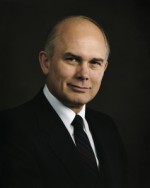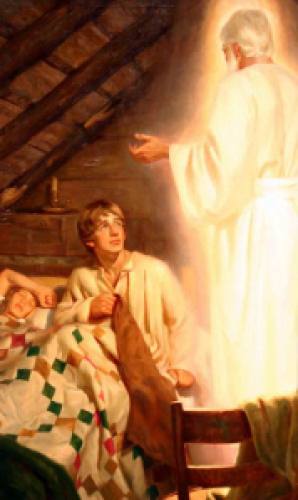Much of the discussion in 1st Thessalonians has to do with becoming converted to Jesus Christ. 1 Thessalonians 1:7-10, 2:12, 3:12-13, and 4:1-5 all emphasize the importance of Christians “walking the walk” of a Christ-centered life.
As it is stated in the Book of Mormon: “Marvel not that all mankind, yea, men and women, all nations, kindreds, tongues and people, must be born again; yea, born of God, changed from their carnal and fallen state, to a state of righteousness, being redeemed of God, becoming his sons and daughters; And thus they become new creatures; and unless they do this, they can in nowise inherit the kingdom of God” (Mosiah 27:25-26).
The Challenge to Become
The Apostle Paul taught that the Lord’s teachings and teachers were given that we may all attain “the measure of the stature of the fulness of Christ” (Eph. 4:13). This process requires far more than acquiring knowledge. It is not even enough for us to be convinced of the gospel; we must act and think so that we are converted by it. In contrast to the institutions of the world, which teach us to know something, the gospel of Jesus Christ challenges us to become something.
Many Bible and modern scriptures speak of a final judgment at which all persons will be rewarded according to their deeds or works or the desires of their hearts. But other scriptures enlarge upon this by referring to our being judged by the condition we have achieved.
The prophet Nephi describes the Final Judgment in terms of what we have become: “And if their works have been filthiness they must needs be filthy; and if they be filthy it must needs be that they cannot dwell in the kingdom of God” (1 Ne. 15:33; emphasis added). Moroni declares, “He that is filthy shall be filthy still; and he that is righteous shall be righteous still” (Morm. 9:14; emphasis added; see also Rev. 22:11-12; 2 Ne. 9:16; D&C 88:35). The same would be true of “selfish” or “disobedient” or any other personal attribute inconsistent with the requirements of God. Referring to the “state” of the wicked in the Final Judgment, Alma explains that if we are condemned by our words, our works, and our thoughts, “we shall not be found spotless; . . . and in this awful state we shall not dare to look up to our God” (Alma 12:14).
From such teachings we conclude that the Final Judgment is not just an evaluation of a sum total of good and evil acts–what we have done. It is an acknowledgment of the final effect of our acts and thoughts–what we have become. It is not enough for anyone just to go through the motions. The commandments, ordinances, and covenants of the gospel are not a list of deposits required to be made in some heavenly account. The gospel of Jesus Christ is a plan that shows us how to become what our Heavenly Father desires us to become. 1
Paul also addressed the resurrection when writing this letter to the saints in Thessalonica. This Hellenized city was named after the sister of Alexander the Great (356-323 BC) and was the capital of Macedonia. These saints were no doubt surrounded by those who denied the resurrection of a literal body, and this is a reason why Paul stressed the resurrection so much in his writings. 1 Thessalonians 4:13-18 is the core of Paul’s teaching in Thessalonians on the resurrection and second coming of our savior Jesus Christ.
Occasionally gospel students are asked if they believe in the rapture. Although this term is not used in the King James Version of the Bible, it is important for them to understand what Christians mean by this phrase. Rapture comes to us from 1 Thessalonians 4:17 where Paul says, “Then we which are alive and remain shall be caught up together with them in the clouds, to meet the Lord in the air: and so shall we ever be with the Lord.” The phrase “caught up” is rendered in the Latin Vulgate rapiemur, from the root rapto. This word has given rise in English to the word rapture, now often used by Christians to refer to the second coming of Jesus Christ in clouds of glory when he brings his saints to him in the air. This reminds me of Doctrine and Covenants which reads:
And there shall be silence in heaven for the space of half an hour; and immediately after shall the curtain of heaven be unfolded, as a scroll is unfolded after it is rolled up, and the face of the Lord shall be unveiled; And the saints that are upon the earth, who are alive, shall be quickened and be caught up to meet him. And they who have slept in their graves shall come forth, for their graves shall be opened; and they also shall be caught up to meet him in the midst of the pillar of heaven— They are Christ’s, the first fruits, they who shall descend with him first, and they who are on the earth and in their graves, who are first caught up to meet him; and all this by the voice of the sounding of the trump of the angel of God (Doctrine and Covenants 88:95-98 emphasis added).
This brings added meaning to the words Moroni shared with a young 17 year old Joseph Smith when he said:
For behold, the day cometh that shall burn as an oven, and all the proud, yea, and all that do wickedly shall burn as stubble; for they that come shall burn them, saith the Lord of Hosts, that it shall leave them neither root nor branch (Joseph Smith History 1:37 emphasis added).
The order of the resurrection is something that Paul and other apostles spent time teaching. In another letter written to the Corinthians, Paul said, “For as in Adam all die, even so in Christ shall all be made alive. But every man in his own order: Christ the firstfruits; afterward they that are Christs at his coming” (1 Corinthians 15:22-23). The resurrection is a vital part of our faith in Jesus Christ. Paul essentially states that without faith in Christ to bring to pass the resurrection of the mortal body that our faith is in vain (1 Corinthians 15:14).
The following chart is helpful. I obtained it in a class I attended years ago taught by Robert J. Mathews. I have modified the chart somewhat for it to work in powerpoint, and it has since been published in a book entitled, Selected Writings of Robert J. Matthews.
Notes
1. Elder Dallin H. Oaks, The Challenge to Become, General Conference October, 2000.
2. Robert J. Matthews, Selected Writings of Robert J. Mathews, Deseret Book, SLC, 1999, p. 523.




